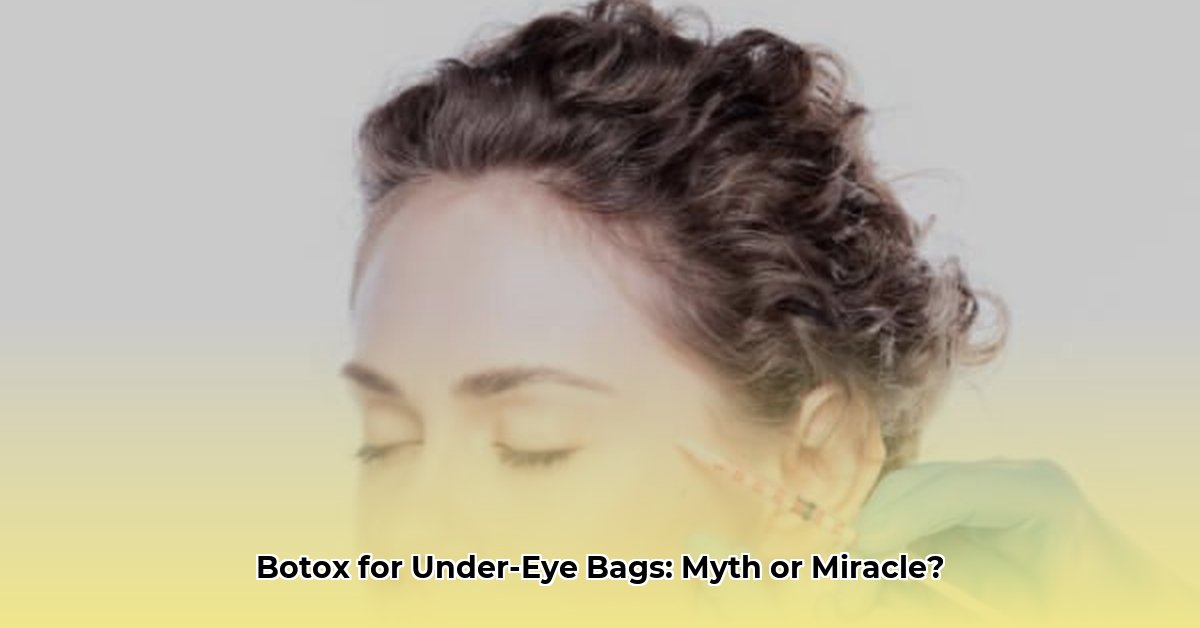Debunking the Botox Myth for Under-Eye Bags
Let’s be upfront: Botox isn’t FDA-approved for treating under-eye bags. While it works wonders for wrinkles caused by muscle contractions (like crow’s feet), under-eye bags are a different story. They’re typically caused by factors Botox can’t address: fat deposits, fluid buildup, or thinning skin due to aging. So, while you might have heard whispers about Botox for under-eye bags, it’s crucial to understand why it’s usually not the right solution.
Why Botox Isn’t the Answer (Usually)
Botox works by temporarily relaxing muscles. Think of it as a tiny, targeted muscle relaxer. It’s great for smoothing dynamic wrinkles, those lines that appear when you make expressions. But under-eye bags aren’t caused by muscle overactivity; they’re a structural issue. Injecting Botox under the eyes won’t magically dissolve fat or tighten loose skin. In fact, in some cases, it can even worsen the appearance of bags by altering the delicate balance of the under-eye area.
When Botox Might Play a (Very) Limited Role
In very rare cases, a minuscule dose of Botox might provide a slight improvement if a specific muscle is contributing to a puffy appearance. This might involve softening the “jelly roll” lines just below the lower eyelid. However, this effect is subtle at best and doesn’t address the underlying causes of true under-eye bags. It’s essential to manage expectations: Botox won’t eliminate bags, it might subtly smooth the skin above them in select cases.
Effective Treatments for Under-Eye Bags
If Botox isn’t the answer, what is? Here are treatments that actually target the root causes of under-eye bags:
-
Dermal Fillers: These injectables replace lost volume under the eyes, smoothing out hollows and reducing the appearance of shadows. They’re like a mini-volumizer, plumping up deflated areas for a more youthful contour. Hyaluronic acid fillers are commonly used and offer temporary but noticeable results. Research suggests that newer filler formulations offer improved longevity and integration with surrounding tissues.
-
Lower Blepharoplasty (Eyelid Surgery): This surgical procedure removes excess fat and tightens sagging skin, providing a long-term solution for significant under-eye bags. While more invasive, it offers the most dramatic and lasting results. Ongoing research explores less invasive surgical techniques with quicker recovery times.
-
Laser Resurfacing: Certain lasers stimulate collagen and elastin production, tightening skin and improving texture over time. This addresses thinning skin and skin laxity. Some experts believe that fractional lasers may be particularly effective for this delicate area, though research continues to refine these approaches.
-
Microneedling with Radiofrequency (RF): Similar to laser resurfacing, this treatment combines microneedles with radiofrequency energy to further boost collagen and elastin. Some studies suggest that this combination may be even more effective at skin tightening than microneedling alone, though further research is needed to confirm these findings.
-
Lifestyle Changes: While not a primary treatment, factors like adequate sleep, hydration, and a low-sodium diet can minimize fluid retention and improve the appearance of puffiness. Cold compresses can also offer temporary relief.
Choosing the Right Treatment & Finding a Qualified Provider
Everyone’s under-eye concerns are unique. A board-certified dermatologist, oculoplastic surgeon, or facial plastic surgeon can accurately diagnose the cause of your under-eye bags and recommend the most suitable treatment plan. They’ll consider your individual anatomy, skin type, and aesthetic goals.
Treatment Comparison Table
| Treatment | Pros | Cons | Approximate Cost | Likely Effectiveness |
|---|---|---|---|---|
| Botox (limited cases) | May soften fine lines below the lower eyelid. Minimally invasive. | Not effective for true bags. Subtle, temporary results. Potential for unwanted side effects. | $300-$600 | Low for bags |
| Dermal Fillers | Immediate results. Non-surgical. Addresses volume loss. | Temporary (6-18 months). Potential for bruising, swelling, or migration. | $500-$1,500 | Medium-High |
| Lower Blepharoplasty | Long-lasting results. Addresses fat and excess skin. | Invasive surgery. Recovery time. Potential scarring. | $3,000-$6,000 | High |
| Laser Resurfacing | Improves skin tone and texture. Stimulates collagen. Minimally invasive. | Multiple treatments may be needed. Downtime. Potential for pigmentation changes. | $1,000-$3,000 | Medium-High |
| Microneedling/RF | Stimulates collagen and elastin. Less downtime than lasers. | Multiple treatments may be needed. Gradual results. | $500-$1,500 | Medium |
Conclusion
Under-eye bags can be frustrating, but there’s hope! While Botox isn’t typically effective, other targeted treatments can provide significant improvement. A consultation with a qualified professional is the first step towards achieving a refreshed, more youthful appearance.
Disclaimer: This information is for educational purposes only and does not constitute medical advice. Always consult with a qualified medical professional for personalized recommendations.
- Bento Box Trays Streamline Restaurant Meal Presentation and Transport - December 13, 2025
- Plastic Bento Boxes Face Scrutiny Over Sustainability Impacts - December 11, 2025
- Bento Tray Revolutionizes Organized Meal Transport and Presentation - December 10, 2025










